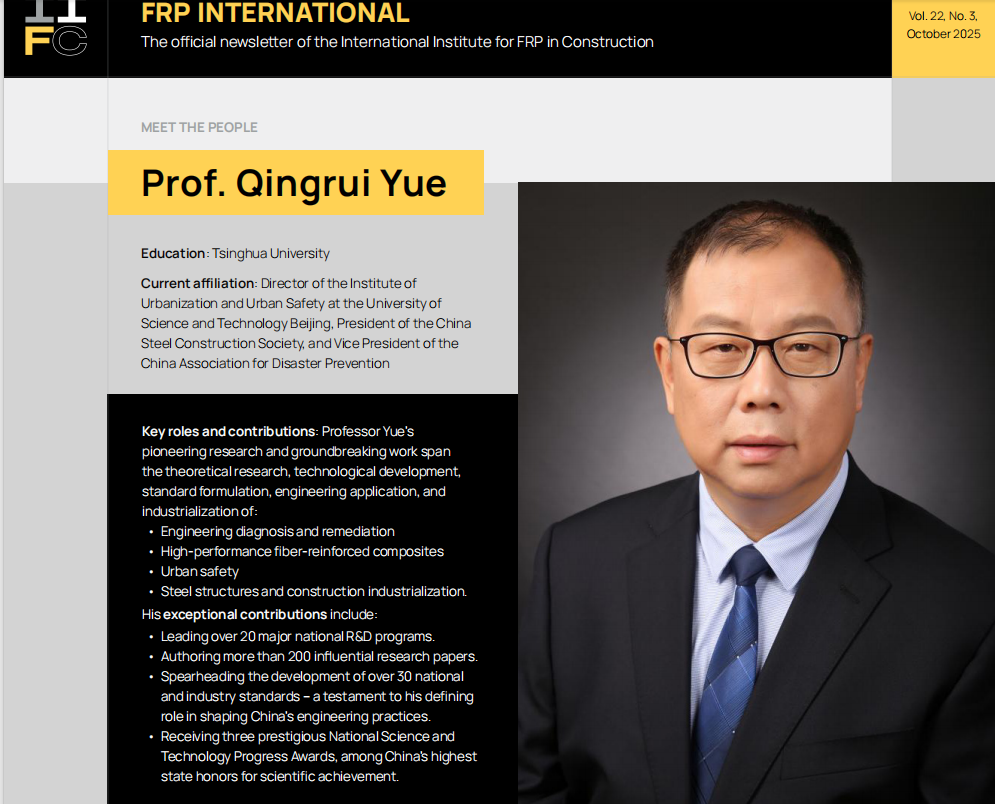USTB is committed to building itself into a high-level research-oriented university
which attaches importance to novel scientific research and promotes independent innovation.
In its October 2025 official publication, the International Institute for FRP in Construction (IIFC) has featured an in-depth interview with Professor Qingrui Yue, Academician of the Chinese Academy of Engineering and a leading expert in composite materials, as part of its “Meet the People” column. This marks the first time a scholar from mainland China has been interviewed in IIFC’s official report, a milestone that underscores China’s growing influence in the global field of civil engineering composites.

As an authoritative international organization in the field of fiber-reinforced polymer (FRP) applications for civil engineering, IIFC’s publications serve as a key communication platform for the worldwide academic and industrial communities. The “Meet the People” column introduces distinguished scholars whose pioneering research has shaped the global development of FRP technology. Professor Yue’s inclusion represents not only a recognition of his personal achievements but also an international acknowledgment of China’s advancing research strength in civil engineering composites.
In the interview, Professor Yue shared his insights into the fundamental theories and engineering applications of FRP materials, focusing on his team’s breakthroughs in high-performance fiber-reinforced composites and their successful use in major infrastructure projects such as bridges, tunnels, and large-scale structures. His work has brought both scientific and social impact, significantly enhancing the durability and efficiency of civil structures. Professor Yue also reflected on his decades-long journey growing alongside China’s FRP industry, expressing hope that young researchers will continue to innovate, remain steadfast in their pursuit of original research, and contribute “Chinese wisdom” to addressing global engineering challenges.
The publication of this feature has elevated the international visibility of China’s FRP research and established a solid foundation for broader international collaboration and exchange in the future.
1. On His Early Inspiration
Professor Yue’s research on FRP began in the early 1990s, inspired by practical challenges encountered in structural rehabilitation projects. He noted that traditional strengthening methods often failed to address root causes such as concrete cracking and steel corrosion. Driven by the need for durable solutions, Yue and his team—composed primarily of young researchers—developed a series of innovative bonding and surface treatment materials, later pioneering the introduction of carbon fiber technologies into China’s civil engineering practice.
2. Overcoming Challenges in Application
Yue recalled that early in FRP promotion, skepticism was widespread regarding its long-term performance and technical feasibility. To address these concerns, his team conducted systematic experimental studies, collected fundamental mechanical and durability data, and investigated international case studies from Europe and Japan. This multi-faceted verification effort helped establish industry confidence and paved the way for the widespread adoption of FRP in China.
3. The Power of Collaboration
Professor Yue emphasized the crucial role of collaboration in advancing FRP technology. In the late 1990s, he and Professor Lieping Ye of Tsinghua University jointly led early-stage carbon fiber strengthening research. In 2000, Yue spearheaded the creation of the FRP Applications Committee under the Concrete and Prestressed Concrete Branch of the China Civil Engineering Society—China’s first professional academic organization dedicated to FRP in construction. Its inaugural conference, attended by over 200 experts including Academicians Zhaoyuan Chen and Zhitao Lü, became a landmark event that helped institutionalize FRP research and foster continuous academic exchange nationwide.
4. Landmark Engineering Projects
Professor Yue recounted several milestone projects that marked the transition of FRP from laboratory research to engineering practice:
-1998 Beijing Electronics Building Retrofit – China’s first large-scale FRP strengthening project, covering thousands of square meters of carbon fiber reinforcement.
-1999 Tiananmen Tower Timber Column Reinforcement – The first application of carbon fiber to wooden structures, effectively solving the long-standing issue of cracked timber columns.
-2008 Baosteel Steel Crane Beam Strengthening – The first FRP application for steel structures in China, preventing fatigue cracking in heavy-duty crane beams that remain in service today.
These projects collectively demonstrated FRP’s versatility, safety, and long-term reliability across structural types.
5. Future Directions in FRP Technology
According to Professor Yue, FRP development can be viewed in four progressive stages:
-Structural Strengthening, now a mature and standardized technology.
-New Structural Applications, including carbon fiber cables for long-span bridges and corrosion-resistant underground projects.
-Lightweight Equipment Design, reducing structural weight and energy consumption by over 50%.
-Extreme Environment Construction, such as extraterrestrial or deep-sea engineering—fields where FRP’s lightweight and high-strength properties make it uniquely valuable.
6. Message to Young Researchers
Professor Yue concluded by encouraging young engineers to remain grounded, patient, and purposeful:
“Make extraordinary achievements through ordinary work. Become a model in both conduct and craftsmanship, and devote yourself wholeheartedly to at least one cause that benefits your country. Be humble and persevering—but never mediocre.”
This landmark feature by IIFC not only celebrates Professor Yue’s lifelong dedication to advancing FRP science and engineering but also highlights China’s emerging leadership in global composite material innovation.